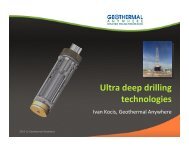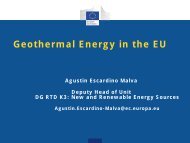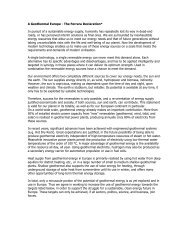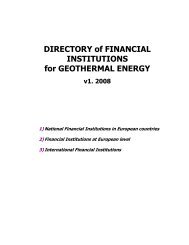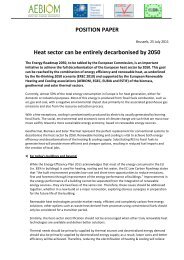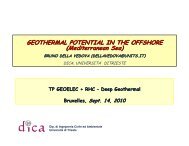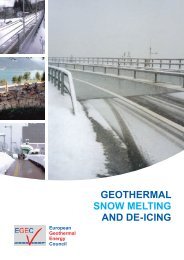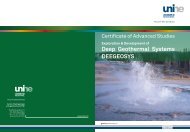Strategic Research and Innovation Agenda for Renewable ... - EGEC
Strategic Research and Innovation Agenda for Renewable ... - EGEC
Strategic Research and Innovation Agenda for Renewable ... - EGEC
Create successful ePaper yourself
Turn your PDF publications into a flip-book with our unique Google optimized e-Paper software.
<strong>Renewable</strong>Heating & CoolingEuropean Technology Plat<strong>for</strong>m100hi2010 2015 202080Solar Thermal6.1.2 <strong>Research</strong> <strong>and</strong> innovation priorities with impact in the Medium <strong>and</strong> Long TermGeothermal60Advanced solutions <strong>for</strong> the integration of large solar thermal systems into smartBiomassthermal/electrical grids (ST.13). R&D is needed on system technology to developadvanced 40 solar based district heating systems, which are also able to deal with acombination of centralized <strong>and</strong> decentralized solar thermal systems, heat pumps,biomass CHP plants <strong>and</strong> waste heat. Smart metering <strong>and</strong> load management systems20are needed to combine solar district heating systems with the electrical grid. Such smartthermal-electrical grids will meet the load balancing needs of combined heat <strong>and</strong> powerproduction 0 in a free market <strong>for</strong> heat, cold <strong>and</strong> electricity.2010 2020 2030TWh<strong>Research</strong> <strong>and</strong> <strong>Innovation</strong> PrioritiesPredominanttype of activityImpactST.12Optimize large-scale solar collector arrays <strong>for</strong> uni<strong>for</strong>m flow distribution<strong>and</strong> low pumping power<strong>Research</strong> By 20201ST.13Advanced solutions <strong>for</strong> the integration of large solar thermal systemsinto smart thermal/electrical grids.<strong>Research</strong> By 2030100%Table 15: research <strong>and</strong> innovation priorities <strong>for</strong> solar thermal applications to DHC80%1970 20200Flexibility6.2 Priorities <strong>for</strong> Biomass DHCBioenergy in industrial processes <strong>and</strong> DHC systems is produced through thermo-chemicalor biological conversion units with one or two trans<strong>for</strong>mation steps. CHP as well as trigeneration(heat-power-cold) 64 are very interesting concepts, both <strong>for</strong> industry <strong>and</strong> DHCnetworks. Due to the rule of decreasing specific investment with increasing network size,such operational <strong>and</strong> technical ef<strong>for</strong>ts can be better h<strong>and</strong>led in larger units which typicallysupply energy to domestic heat consumers connected to a heating grid or to corporatecustomers to per<strong>for</strong>m industrial processes.60%40%20%0%90%20Paybacktime (year)60%Efficiency vofelectricity yield1030%02035 2040 2045 205002000 2020 20500%Figure 41: Projected evolution of biomass <strong>and</strong> biogas CHP plants connected to DHCSolar DHGeothermal DHBiomass DHDC - Abs. Chillers64Cfr. priorities BIO.9<strong>and</strong> BIO.10 in Chapter 5.Raising the capacity <strong>and</strong> efficiency of already existing DHC through cost- <strong>and</strong> energy-0.028efficient solutions is becoming an increasingly important issue. Some hybrid solutions suchas the integration of heat pumps <strong>for</strong> active flue gas condensation are attractive <strong>and</strong> promising.In its report “Best available technologies <strong>for</strong> the heat <strong>and</strong> cooling market in the EuropeanUnion” (2012), the JRC estimates the investment costs of a woodchip Tfg district = 70˚C heating0.026boiler with flue gas condensation at 0.3 - 0.7 M€/MW. The operation costs are estimated tobe around 5 % of the investment costs <strong>for</strong> heat generating capacities between Tfg = 1120˚Cto 50 MW.0.024Tfg = 200˚Ccosts [EUR/kWh]0.02220200.02035 40 45 50 55 60 6565



